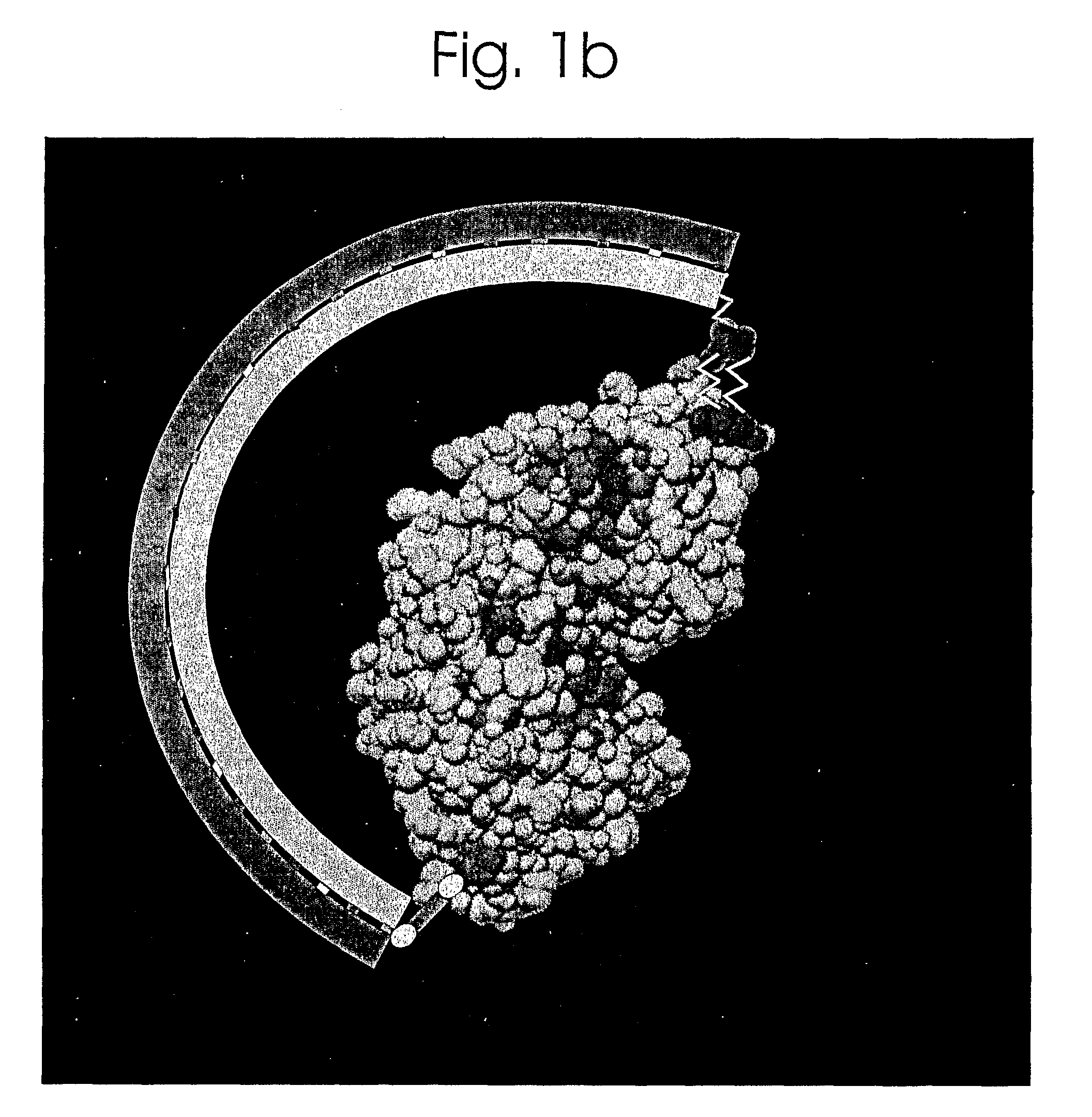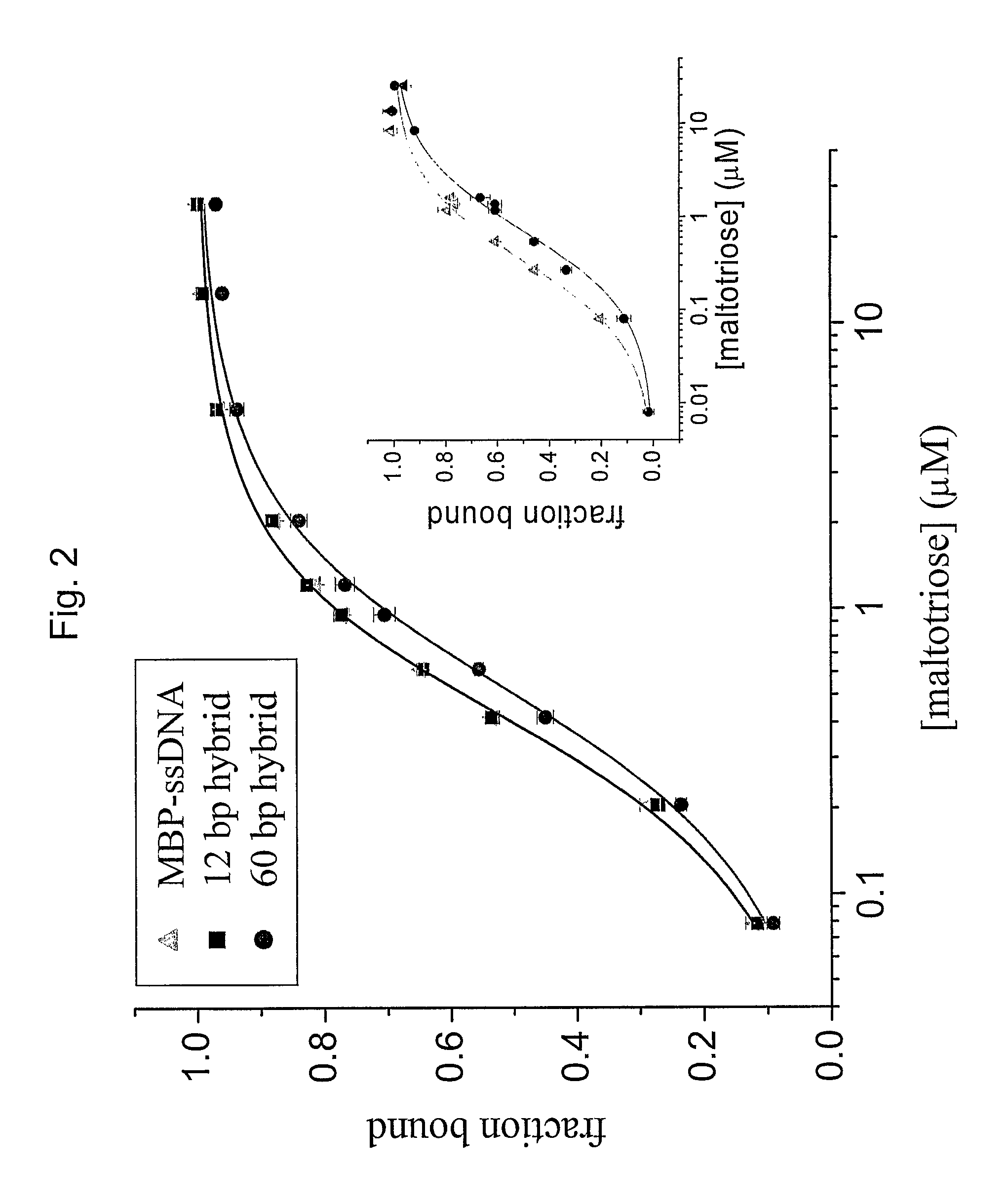Allosteric control of proteins by manipulating mechanical tension
a mechanical tension and allosteric control technology, applied in the direction of instrumentation, transferase, enzyme stabilisation, etc., can solve problems such as affecting function, and achieve the effect of increasing lowering the binding affinity of polypeptides
- Summary
- Abstract
- Description
- Claims
- Application Information
AI Technical Summary
Problems solved by technology
Method used
Image
Examples
example 1
Artificial Allosteric Control of Maltose Binding Protein
[0078]In this example, we demonstrate the allosteric control of a protein based on mechanical tension. When substrate binding is accompanied by a significant change of conformation of the protein, a mechanical tension favoring one or the other conformation will alter the binding affinity for the substrate. We have constructed a chimera where the two lobes of the maltose binding protein are covalently coupled to the ends of a DNA oligomer. The mechanical tension on the protein is controlled externally by exploiting the difference in stiffness between single stranded and double stranded DNA. We report that the binding affinity of the protein for its substrates is significantly altered by the tension.
[0079]The system described herein utilizes the Maltose-Binding Protein (MBP) of E. coli, the periplasmic component of the maltose transport system. Maltose binds in the cleft between the two lobes of the structure (FIG. 1), inducing a...
example 2
Allosteric Control Through Mechanical Tension
[0114]This example demonstrates insertion of a “molecular spring” on the enzyme Guanylate Kinase, to control the conformation of this protein. The stiffness of the spring can be varied externally, which allows exertion of a controlled mechanical tension between the two points on the protein's surface where the spring is attached. The example shows that by applying and releasing the tension, it is possible to reversibly turn the enzyme off and on.
[0115]Most enzymes in the cell are directly regulated by allosteric control. Unlike the control of gene expression, this mechanism provides fast response and is crucial in signaling pathways. In allosteric control, the signaling molecule binds to the enzyme at a site (A) distinct from the substrate's binding site (S). Separating A and S is an essential design feature because the substrate and the controlling molecule can then be unrelated chemically. Qualitatively, the local binding force at A pro...
example 3
Mimicking cAMP Dependent Allosteric Control of Protein Kinase a Through Mechanical Tension
[0144]This example describes the activation of an enzyme complex by mechanical tension. Protein kinase A, a tetrameric enzyme that, in the cell, is allosterically controlled by cAMP, has been modified by the insertion of a “molecular spring” on the regulatory subunit. This allows the exertion of a controlled mechanical tension between the two points on the protein's surface where the spring is attached. We show that upon applying the tension we can activate the enzyme, with efficiency comparable to the activation by its natural regulatory molecule, cAMP.
[0145]Many experimental results on allostery can be understood in terms of a thermodynamic model first introduced by Monod, Changeux, Wyman and later modified in different ways, where the general mechanism is that regulatory molecules and substrates bind to different conformations of the protein with different binding constants. In contrast, her...
PUM
| Property | Measurement | Unit |
|---|---|---|
| force | aaaaa | aaaaa |
| mechanical tension | aaaaa | aaaaa |
| distance | aaaaa | aaaaa |
Abstract
Description
Claims
Application Information
 Login to View More
Login to View More - R&D
- Intellectual Property
- Life Sciences
- Materials
- Tech Scout
- Unparalleled Data Quality
- Higher Quality Content
- 60% Fewer Hallucinations
Browse by: Latest US Patents, China's latest patents, Technical Efficacy Thesaurus, Application Domain, Technology Topic, Popular Technical Reports.
© 2025 PatSnap. All rights reserved.Legal|Privacy policy|Modern Slavery Act Transparency Statement|Sitemap|About US| Contact US: help@patsnap.com



